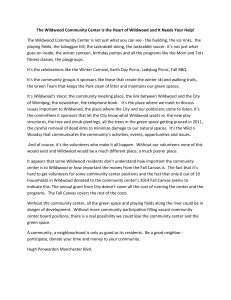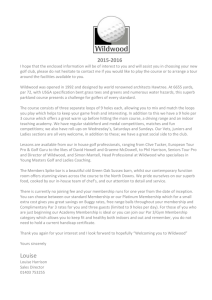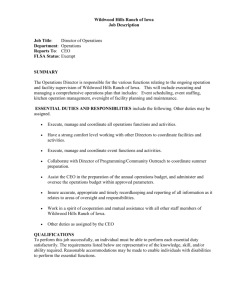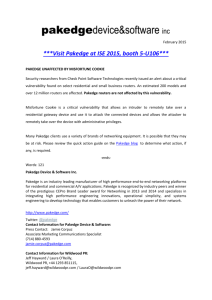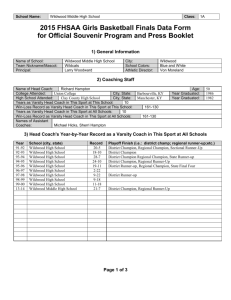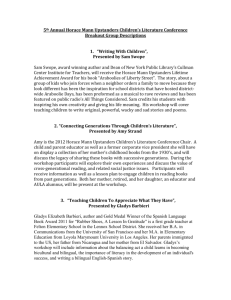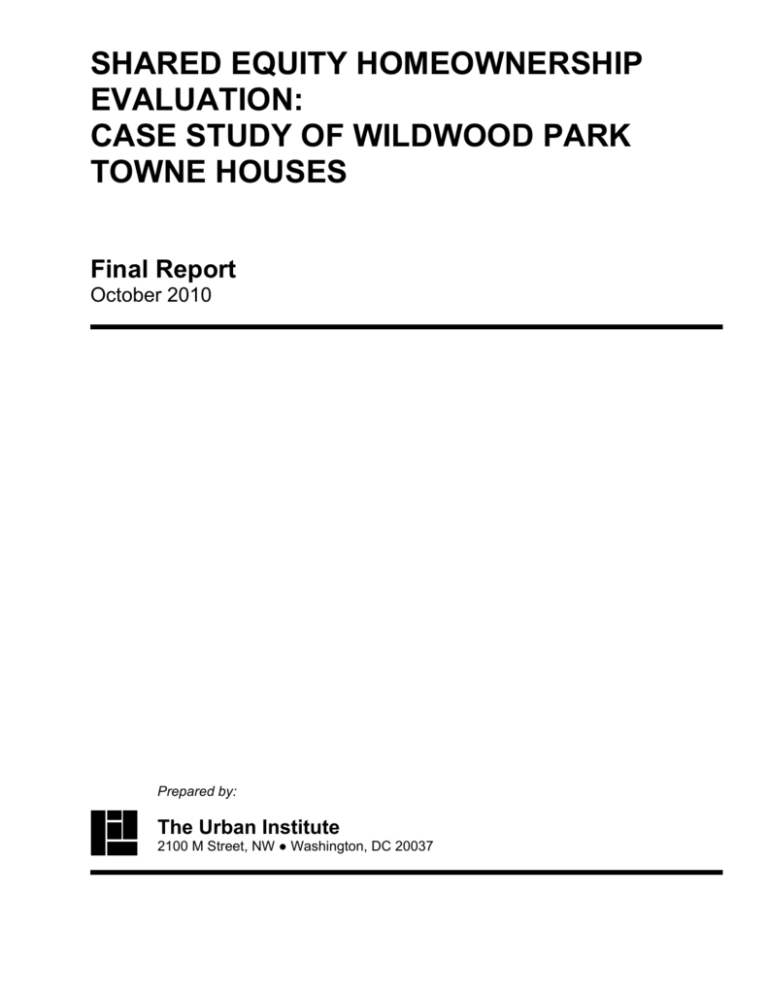
SHARED EQUITY HOMEOWNERSHIP
EVALUATION:
CASE STUDY OF WILDWOOD PARK
TOWNE HOUSES
Final Report
October 2010
Prepared by:
The Urban Institute
2100 M Street, NW ● Washington, DC 20037
Shared Equity Homeownership Evaluation:
Case Study of Wildwood Park Towne Houses
Final Report
October 2010
Prepared By:
Kenneth Temkin
Brett Theodos
and
David Price
The Urban Institute
Metropolitan Housing and Communities
Policy Center
2100 M Street, NW
Washington, DC 20037
Submitted To:
NCB Capital Impact
2011 Crystal Dr., Suite 800
Arlington, VA 22202-3709
UI No. 08387-000-00
Copyright © 2010. The Urban Institute. All rights reserved. Except for short quotes, no part of
this report may be reproduced or used in any form or by any means, electronic or mechanical,
including photocopying, recording, or by information storage or retrieval system, without written
permission from the Urban Institute.
The nonpartisan Urban Institute publishes studies, reports, and books on timely topics
worthy of public consideration. The views expressed are those of the authors and
should not be attributed to the Urban Institute, its trustees, or it funders.
I.
Introduction This case study analyzes outcomes for the Wildwood Park Towne Houses (Wildwood), a 268unit limited equity housing cooperative located in Atlanta, GA. The cooperative has information
on 140 resales that took place since 1972: a sample of resales that took place prior to 2004 and
all resales from 2004 through the end of 2009. Using the available client-level data provided by
Wildwood, we present analyses and findings that address the following four research topics:
1. Affordability: Is the program effective in creating and preserving affordability for lowand/or moderate-income households?
2. Security of Tenure: Is the program effective in maintaining high levels of owneroccupancy for its participants?
3. Personal Wealth: Is the program effective in building wealth for individual households,
providing opportunities for financial gains that are unavailable to renters?
4. Mobility: Are program participants able to sell their shared-equity homes and move into
other housing and neighborhoods of their choice?
II.
Program Description Wildwood was constructed in five phases from 1968 through 1971. This limited equity housing
cooperative, serving low-income households, was developed with federal assistance under
HUD’s Section 236 Interest Reduction Program. 1 The 268-unit cooperative is governed by a
seven-person board of directors elected by the resident members of the cooperative. All seven
directors reside at Wildwood. Cooperative housing, as structured at Wildwood, works as follows:
to become a voting member of the housing cooperative a person buys a share or membership
certificate in the cooperative housing corporation, giving her an exclusive right to occupy one of
the cooperative's dwelling units. Members occupy their private dwelling unit pursuant to a
proprietary lease, also known as an occupancy agreement. Each member of the cooperative
possesses, therefore, an individual and transferrable interest in the corporation that owns the
real estate development, along with a leasehold interest in a specified dwelling unit. The
cooperative’s board of directors provides overall governance and operational guidance.
CornerStone Cooperatives Inc. manages Wildwood under a property management agreement,
renewed and approved each year by Wildwood’s board of directors. CornerStone Cooperatives
is a for-profit corporation that is owned by Alex and Cathy Miller, both of whom are involved in
1
This interest subsidy program was enacted as part of the Housing and Urban Development Act of 1968.
Under Section 236, both rental and cooperative housing projects were financed through private financial
institutions, with 40-year mortgages insured by FHA at a market rate. Mortgage interest payments were
made to the lenders as if the interest rate on the mortgage was 1 percent. HUD paid the lender (i.e., the
mortgagee) the difference between 1 percent and the market rate. The 1 percent interest rate charged to
the project meant that a small amount of net income collected from the project’s residents could support
the large debt taken on to construct this housing.
1
the day-to-day management, maintenance, financial accounting and reporting for the property.
Wildwood contains a mix of units, ranging from one-bedroom flats to four-bedroom townhomes
with basements. The cooperative’s buildings are frame constructed. The units are all located on
a contiguous parcel of land. The breakdown of unit types and sizes, with the monthly carrying
charges for each (current as of December 2009), are as follows:
1-Bedroom.................................................. $367
2-Bedroom Townhouse .............................. $415
2-Bedroom Tri-level .................................... $438
2 Bedroom Townhouse with basement ...... $484
3-bedroom Tri-level .................................... $503
3-Bedroom Townhouse with basement ...... $529
4-Bedroom Townhouse with basement ...... $567
These monthly fees, charged to the cooperative’s residents, cover the cooperative’s general
operating costs, including mortgage, insurance, taxes, and property management, as well as
paying for water, sewer, and natural gas (heating, cooking, and hot water) for the individual
dwellings. The cooperative also credits $30 a month to each member’s account which can be
used for improvements, replacements of items like appliances and flooring, or repairs in his or
her unit.
Until the HUD-insured mortgage is paid off in August 2011, the cooperative must retain a HUDapproved limited equity resale formula, which determines the maximum transfer value of a
homeowner’s share when leaving the cooperative. The resale price for a particular unit is based
on the number of years since the first principal payment was made on the property’s mortgage
(see Table 1, below). For example, if a one-bedroom home was bought in 1974 and resold in
1994, the reseller can raise the sale price by $60 for each of the first seven years (for $420
total), $89 for the next ten years (for $890 total), and $149 for the next two years (for $298 total)
for a maximum total increase of $1,608 ($420 + $890 + $298). In addition, the sale price may
increase more if capital improvements are made by an occupant; the value of this increase is
negotiable between buyer and seller. The above guidelines set the maximum price that
resident-members can charge for the resale of their shares. Wildwood memberships can sell for
less than the maximum. Although almost all shares do sell for this maximum, owners are not
guaranteed they will receive the full allowable appreciation increases.
Prospective buyers, after inspecting the unit for sale, submit a purchase offer for consideration
by the seller. Both the price and terms (including financing, closing dates and furnishings) are
negotiable. Wildwood’s property manager reports that although individual members sometimes
find their own buyer (often a friend or relative), most sales are made using the cooperative’s
optional listing and marketing services. The cooperative markets its units for sale using real
estate signs and listing on the www.atlantacooperatives.org web site. The cooperative closes all
its membership sales in-house. It charges a $100 transfer fee for all sales, plus a $750 fee for
listing and closing when the cooperative’s services have been used.
2
Table 1: Allowable annual increases to Wildwood Units Maximum Transfer Value
Type of unit
1975 1982 1992 2002 1981
1991
2001
2011
$60
$89
$149
$298
1-Bedroom
2-Bedroom Townhouse
$71
$107
$178
$355
2-Bedroom Tri-level
$67
$101
$168
$336
2 Bedroom Townhouse with basement
$79
$118
$196
$393
3-bedroom Tri-level
$82
$122
$204
$408
3-Bedroom Townhouse with
basement
$86
$129
$215
$431
4-Bedroom Townhouse with
basement
$92
$138
$230
$461
Source: Bylaws of Wildwood Park Towne Houses, Inc.
The cooperative’s bylaws and the occupancy agreement signed by each resident-member
grants the cooperative lien rights against all sums due to it from any member. Proceeds from
the resale of member shares are itemized at closing to protect the lien interests of the
cooperative and to ensure the payment of any sales-related fees. Whatever is owed to the
cooperative is deducted before sales proceeds. The balance of the sales proceeds are paid to
the seller upon closing of the sale. Although the bylaws grant the cooperative a preemptive
option to re-purchase the members’ shares, the cooperative has never exercised that option. All
resales have occurred as a direct seller-to-buyer transaction, with the cooperative overseeing
the transfer to ensure that shares are resold for no more than the maximum transfer value.
CornerStone Cooperatives Inc. and the boards of Wildwood and several other cooperatives in
the Atlanta area created Share Credit Corp. in 1995, a 501(c)(3) non-profit to provide loans to
co-op members for purchasing co-op shares, making home improvements, and meeting other
financial needs. According to Share Credit’s website, the corporation targets its lending to
households with incomes of less than eighty percent of area median income, although
borrowers with incomes above this threshold are sometimes served. 2 Share Credit’s
underwriting policy authorizes it to offer loans up to $30,000 for cooperative home purchases
and home improvements. It also authorizes it to offer “equity” loans up to $1,200 with a term up
to 24 months simply on the equity value of the membership. Except for “equity” loans, the loan
term for loans under $10,000 are self-amortizing with a term up to 84 months. Loans above
$10,000 have self-amortizing terms up to 120 months. The current loan interest rate is 9.5
percent.
The cooperative’s bylaws provide that all prospective purchasers of member shares obtain the
consent of the board of directors prior to the closing of a sale. This consent is granted or denied
2
Share Credit Corporation: The financial services arm of The Southeast Association of Housing
Cooperatives Atlanta, Georgia. http://www.atlantacooperativeeratives.org/share.html.
3
after a meeting with the board of directors during which are discussed the responsibilities of
cooperative homeownership and the expectations of the community of any household living in it.
The board of directors is also required to approve any share loan that the Share Credit Corp.
provides prior to the issuance of such a loan. Property management provides copies of the
cooperative’s important documents and reviews them with prospective members prior to closing
a sale. This review covers the bylaws, occupancy agreement, house rules, and other policies
that govern the cooperative or guide a member’s use or improvement of her unit.
The cooperative does not provide pre- or post-purchase counseling. However, members have
access to on-site property management. Wildwood is an active member of the Southeast
Association of Housing Cooperatives. The association provides support and training for housing
cooperatives’ leaders and their members. At Wildwood’s annual meeting, the board of directors
provides all resident members with an annual report that describes the financial condition of the
cooperative and other relevant information. It is during the annual meeting that members also
elect or re-elect persons to the board of directors.
III.
Summary of Wildwood Sales and Homebuyers Our analysis of Wildwood’s performance, addressing each of the four research topics of
affordability, personal wealth, security of tenure, and mobility, was based on client-level
information provided by the cooperative’s property manager, CornerStone Cooperatives Inc. We
focused on 408 membership sales and resales that took place between 1972 and 2009. The
median price that was paid by these low-income households to gain access to one of
Wildwood’s co-op units was $5,524, calculated in constant 2008 dollars.
Table 2: Selected Characteristics of Wildwood Memberships and Homebuyers
268
Number of units as of 12/31/2009
Number of resales reported by Wildwood: 1997-2009
140
Total number of sales reported by Wildwood: 19722009
408
Median share price paid by homeowner (in 2008 $)
$5,524
Median down payment and closing costs paid by
purchaser (in 2008 $)
$1,249
Median household income of purchasers (in 2008 $)
$24,545
Source: Authors’ analysis of Wildwood client-level data
The ability to purchase cooperative shares for a relatively modest amount provided a
homeownership opportunity for lower income households who might not have otherwise been
able to purchase an average home in Atlanta. Wildwood’s resident members had a median
household income (in 2008 $) of $24,545, which was 35.5 percent of the surrounding
4
metropolitan area’s 2008 median family income of $69,200. 3
IV.
Findings In this section we present our analyses that address each of the four research topics:
affordability, personal wealth, security of tenure, and mobility.
1.
Affordability
The median income of households who purchased Wildwood shares, as a proportion of the
County’s median income did not vary much over time. In any given year, the median household
income of Wildwood’s homebuyers ranged between 25 and 40 percent of the area median. In
most years, the median income of these households was around 35 percent (see Figure 1).
Share of Atlanta Metro Area Median Family Income
Figure 1: Median HH Income of Wildwood Buyers Relative to Median Family Income for
Atlanta Metro Area, 1972-2009
80%
70%
60%
50%
40%
30%
20%
10%
0%
9
6
3
0
7
4
1
8
5
2
8
5
2
197 197 197 198 1 98 198 199 199 1 99 2 00 200 200 2 00
Source: Authors’ Analysis of Wildwood client-level data
The Atlanta housing market has seen significant appreciation over the past 3 decades, followed
by a marked fall in property values. According to data from the Federal Housing Finance
Agency (FHFA), home prices rose by 469 percent between 1976 and 2008 in the Atlanta
metropolitan area before falling by 10 percent by the end of 2009. While the FHFA publishes a
3
Atlanta is located in the Atlanta-Sandy Springs-Marietta, GA HUD Metropolitan FMR Area. See the HUDdefined median family income here: http://www.huduser.org/portal/datasets/il/il08/ga_fy2008.pdf. This
number differs from the median household income in Fulton County, GA (where most of Atlanta is located)
of $62,282. This data from the Economic Research Service is derived from Bureau of Labor Statistics
Local Area Unemployment Statistics data. See: http://www.ers.usda.gov/Data/Unemployment/.
5
housing price index for the Atlanta metropolitan area, it is uncertain whether, or to what extent,
the cooperative market tracks the larger for-sale housing market. We therefore cannot describe
pricing changes in the demand for and pricing of housing cooperatives beyond the Wildwood
properties. The mean price of condominiums in Atlanta in 2008 was $262,785 according to the
ACS; because this price is so far above what someone on Wildwood’s average income could
afford, it is unlikely that residents would have been able to afford many homes in the Atlanta
market. Median gross rent in Atlanta in 2008, at $867 according to the ACS, was also higher
than many Wildwood residents could afford.
One of the major objectives of a shared equity homeownership program like Wildwood’s is to
ensure that the price of any homes that are resold will remain permanently affordable for
successive generations of lower income homebuyers. The key question is whether or not the
home remains affordable to the next buyer. There are many ways to measure the continuing
affordability of renter-occupied or owner-occupied housing, although every method begins with
the basic assumption that “housing affordability is a measure of housing costs relative to
income.” 4 Previous analyses of changes to the affordability of shared equity homes have used
the minimum income required to purchase a home as the indicator of the housing cost and the
area’s median family income (MFI), published by HUD. 5 To the extent that the ratio of the
minimum income required to purchase a home relative to the MFI is the same, when a home is
initially purchased and when that home is resold, the unit is considered to have maintained its
affordability. (We refer to this method as the MFI method.)
This MFI method measures, at two separate points in time, the required minimum income to
purchase a given home relative to the MFI. A problem with this methodology is that it does not
measure changes to a particular household’s income over time; rather, it assumes the incomes
of the target population for whom shared equity homes are being kept affordable and to whom
these homes are being resold increase at the same rate as the MFI. But, as discussed earlier,
the incomes of the families purchasing shared equity homes in Atlanta are well below the area
median family income; and the minimum income required to purchase a shared equity home is
often lower than the purchasers’ actual income. Given uneven income growth for families
earning less than the median, using the MFI to calculate affordability may overstate the extent to
which homes remain affordable to lower income families because the growth in MFI reflects
changes to the types of households living in the area at the two different points in time (initial
sale and resale) as well as changes to incomes for households that are present at both time
periods. 6
4
Goodman, Jack. 2001. Housing Affordability in the United States: Trends, Interpretations, and Outlook. A
Report Prepared for the Millennial Housing Commission, page 3.
5
See, for example, Davis, John Emmeus and Alice Stoke. 2009. Lands in Trust, Homes That Last: A
Performance Evaluation of the Champlain Housing Trust. Burlington VT: Champlain Housing Trust.
6
See, for example, Gangl, Markus. 2008. “A Longitudinal Perspective on Income Inequality in the United
States and Europe. Focus” Vol. 26(1). The author reports, using data from the Panel Study of Income
Dynamics, that the income for households within the bottom three income deciles between 1992 and 1997
either remained the same or declined during the five-year period.
6
Despite these drawbacks, the MFI method has two distinct advantages: its sensitivity to local
area differences in incomes and family size; and its widespread use by policy analysts in
evaluating major housing assistance programs funded by HUD, where eligibility is set by
7
household income relative to median incomes in the local area. As a result, we analyzed
changes to the affordability of resold units, comparing changes in required income relative to
MFI.
Recognizing the issues associated with the MFI method, we first calculated the absolute
changes in required real minimum income to purchase a home at resale. This measure
establishes the required income growth for a given household to purchase a home at resale,
and so identifies the extent to which the same household earning the required minimum income
at a given point in time can afford a unit when it is resold. Consequently, it is not dependent on
an area’s changes in income distribution or household structure; rather, it provides information
about the income growth required for a particular cohort of households to be able to afford a
home at resale.
Starting with the absolute measure, we calculated the real income required for the initial
purchase and subsequent resale of the cooperative units, assuming that the buyer would
finance the purchase with a 5-year, fixed rate mortgage that had an interest rate that was the
median interest rate for all buyers. In addition, we assumed that the buyer paid a down payment
that was equal to the median down payment share of all homes sold under the program, and
further assumed that the buyer would spend no more than 33 percent for his/her income for
housing (which included the mortgage payment and any property taxes or co-op fees reported
by the program).
Based on the length of time between the two sales, we calculated the average annual increase
in the required minimum income. For example, assume that a home requires a minimum income
(in 2008 $) of $20,000 at the initial sale, and, at a resale that takes place 3 years later, requires
a minimum income (in 2008 $) of $22,000. The real income at resale is 10 percent greater than
at the initial sale, which means that the required minimum income increased by an average of
3.3 percent per year. To the extent that real incomes increased by the same amount for
households earning $20,000 at the time of the initial sale, the unit remains affordable to such
households. Using this methodology, we calculated that the real required minimum income
decreased between units’ initial and subsequent resale by 0.7 percent per year, which shows
that units decreased in their cost over time. Given this relationship, it is not surprising that 99
percent of resold units had a required minimum income for purchase that was no greater than
10 percent (in real terms) of the income needed for the initial sale.
In addition, we ran a regression in which the percentage change in required minimum income
was the dependent variable and length of tenure was the explanatory variable. The parameter
estimate from this regression indicates the percentage change in the minimum income (in real
$), by year, that is required to purchase the home. Our analysis revealed a small but significant
7
Goodman, page 17.
7
relationship between the extent to which the affordability of a resold home declined and the
length of time that the initial purchaser lived in the home. Living in the home for an additional
year is associated with a 0.7 percentage point increase in income needed.
Figure 2: Changes in Income Needed vs. Years Owned
Change in Income Needed
120%
70%
20%
0
5
10
15
20
25
30
35
40
-30%
-80%
Years Owned
Source: Authors’ analysis of Wildwood client-level data.
Note: An increase in tenure of one year is associated with a 0.7 percentage point increase in income needed. This is
significant at the .01 level.
Turning to the relative measure, the median minimum income required to purchase a Wildwood
unit that was subsequently resold was 27.7 percent of the area MFI. These homes, when
resold, required a median minimum income that was 28.2 percent of area MFI. The median
difference between these two ratios for all of the units resold by Wildwood was 0.3 percentage
points, which indicates that units retained their affordability. As shown in the following figure, 89
percent of resales had the required minimum income, as a share of area MFI, increase by less
than 5 percentage points, which suggests that units retained their affordability over time.
8
Figure 3: Percentage Point Change in Income (as a share of Median Family Income)
Needed for Wildwood Homes, Initial Purchase vs. Later Resale
100
87
90
80
70
60
50
40
30
20
10
0
11
0
9
3
Decline by 15 Decline by 10 Decrease by 5
percentage
- 15
- 10
points
percentage
percentage
points
points
3
Change by
less than 5
percentage
points
0
Increase by 5 - Increase by 10 Increase by
10 percentage
- 15
more than 15
points
percentage
points
points
Source: Authors’ analysis of Wildwood client-level data.
Note: We assume that one-third of income is paid in principal, interest, taxes, insurance with a 9.5% 5-year fixed-rate
share loan and 25 percent down, combined with the cooperative fee.
Wildwood’s units have largely remained affordable since the cooperative’s founding in 1968.
The project’s HUD mortgage matures in 2011, however. When the mortgage is paid off,
Wildwood will no longer be bound by a regulatory agreement with HUD that restricts allowable
increases in share prices. The cooperative’s board currently intends to remove these resale
restrictions. It is unclear how much affordability will be eroded in the future by market pressures.
2.
Personal Wealth
Resellers received the entire principal amount they had paid off on the loan they had taken out
to finance the purchase of their member shares. Because these share loans had a relatively
short term (the median term was 5 years), resellers had paid down nearly all of their share loans
by the time of their move, since the median length of tenure for resellers was 6.6 years. The
combination of principal paid on the share loan and the appreciation received on resale resulted
in resellers walking away with a median of $6,277 (in 2008 $) in cash from the closing table.
About a third of the sellers’ proceeds were appreciation. Considering only those proceeds that
came from appreciation, Wildwood’s resellers realized a net gain in equity of $2,015 on an initial
investment (down payment and closing costs) of about $1,250. Using these figures, we
calculate the median return realized by resellers, which was 14.1 percent. 8
8
IRR is defined as [(seller’s share of the home’s appreciation + his or her down payment + any capital
(1/yrs_owned)
– 1. This internal rate of return does not include 19
improvements) / his or her down payment]
9
The 14.1 percent rate of return realized by Wildwood resellers exceeded the returns that those
resellers would have earned if they had rented a unit and invested their down payment in stocks
(7.8 percent median return if Wildwood resellers invested their down payment amount in an
S&P 500 index fund). Their returns were also greater than investments in 10-year Treasury
bonds, which had a median yield at the time that the resellers initially purchased their home of
5.7 percent. 9 Not all Wildwood owners saw such high rates of return, though; 24.3 percent of
Wildwood resellers saw negative effective appreciation, and only 74.4 of Wildwood homeowners
with an IRR calculated saw a higher return than they would have realized with either stocks or
bonds. On the other hand, 20.7 percent of Wildwood resellers saw internal rates of return of at
least twice Wildwood’s median, and 4.3 percent saw rates of return of over 100 percent (see
Figure 3). Note that residents with short tenures have greater variability in IRR; because of this,
many resellers with very high and very low rates returns actually had fairly low effective
appreciation in dollar terms.
Note that the calculated IRR does not include any savings that a member realizes from the
difference between the total monthly costs (payments on the share loan and cooperative fees)
and the market rent for the occupied unit. Although we do not know the imputed rent for
Wildwood’s units, it is likely that cooperative members pay less for housing than if they rented a
comparable unit: median total monthly payment for all Wildwood owners, in 2008 dollars is
(before-tax) $581, 10 while the 2008 median gross rent, according to the ACS in Atlanta is $867.
Therefore, our calculated IRR represents a lower bound on the return realized by members.
There are other benefits and costs to homeownership that we have also excluded from our
analysis. Benefits include the deduction of house and mortgage interest paid from income tax
liabilities, any homebuyer tax credits, and stabilization of housing payments (for those with fixed
rate mortgages). Added costs include maintenance costs, realtor fees, and other transfer and
transaction costs.
sales in which the reseller’s proceeds did not exceed the remaining balance on his/her mortgage, resulting
in negative proceeds. It is impossible to compute an internal rate of return in such a circumstance.
9
We assume that Wildwood resellers would hold their 10-year Treasury bonds until maturity, and so did
not calculate any gains or losses that would have resulted from selling their bonds at the time that the
owners sold their Wildwood homes.
10
A portion of the cooperative fee is tax deductable, as is the interest on the share loan. We do not know
the proportion of cooperative members who itemize deductions, and so we do not factor this additional
savings into our IRR calculation.
10
Figure 4: Rates of Return for Resold Homes in Wildwood
52
55
Number of Resold Homes
50
45
40
35
34
30
25
21
20
15
11
9
10
7
6
5
0
Negative
0 - 10%
10% - 20%
20% - 30%
30% - 40%
40% - 100%
100%+
Internal Rate of Return
Note: Negative IRR includes 19 sales in which the reseller’s effective appreciation is negative and larger in magnitude
than the down payment.
Source: Authors’ analysis of Wildwood client-level data.
Table 3: Summary Characteristics of Wildwood Purchase Transactions
$5,554
Median purchase price (in 2008 $)
Share of purchasers who received share loans
Median share loan among those with a loan (in 2008 $)
71.3 percent
$4,944
Share of first-lien mortgages with fixed interest rates
100 percent
Median initial interest rate on first-lien mortgages
9.5 percent
Median term of first-lien mortgages
5 years
Median down payment and closing costs paid by
purchaser at closing (in 2008 $)
$1,250
Median percent of sales price paid in down payment
24.9 percent
Median principal paid on share by resellers (in 2008 $)
$3,700
Median appreciation realized by resellers (in 2008 $)
$2,015
Median forced savings - principal paid on mortgages
other than down payment (in 2008 $)
$2,564
Median proceeds realized by resellers (in 2008 $)
$6,277
Median Internal Rate of Return Earned by resellers
14.1 percent
Source: Authors’ analysis of Wildwood client-level data
Note that the differences in rates of return vary slightly depending on the year that a Wildwood
share was resold. Nearly 90 percent of Wildwood’s reported resales (125 out of 140) occurred
between 2004 and 2009. The median internal rate of return earned by resellers between 2004
11
and 2009 ranged from 11 to 17 percent (Figure 4). The internal rate of return for resellers in
each of the six years was greater than the return they would have realized in the stock market
or by purchasing a risk-free 10-year Treasury bond.
Figure 5: Comparison of Median Rates of Return for Alternative Investments
20%
Wildwood's Homeowners
S&P 500
N=23
N=11
10-Year Treasury
15%
N=18
N=19
N=20
N=18
10%
5%
0%
2004
-5%
2005
2006
2007
2008
2009
Year of Resale
Source: Authors’ analysis of Wildwood client-level data; Treasury data (http://www.ustreas.gov/offices/domesticfinance/debt-management/interest-rate/yield_historical_main.shtml); S&P 500 data
(http://www.irrationalexuberance.com/)
We do not compare members’ actual returns to IRRs that would have been achieved had a
member purchased a market-rate cooperative unit, or a single family house. We do not know if
a member could have purchased a market-rate unit, and it is unlikely that a member could have
afforded a condominium, given that the mean price in Atlanta, in 2008, for such units was
$262,785 according to the ACS. Assuming that a member had sufficient funds for a 3 percent
down payment, the monthly share loan payment would have been $1,528, assuming a 30-year
fixed rate loan at 6.0 percent. This payment would require an annual income of over $55,000,
well higher than actual median income of approximately $24,500 for Wildwood homebuyers.
3.
Security of Tenure
In the current economic environment, where many low-income homeowners have lost their
homes to foreclosure, security of tenure is an important outcome against which to judge shared
equity homeownership programs. As a result of the mortgage meltdown, some policymakers
and stakeholders are questioning the wisdom of programs that expand homeownership
opportunities to lower income families. The cooperative model, however, is appreciably different
12
from traditional affordable homeownership strategies. We investigate whether Wildwood buyers
were able to retain their homes, avoiding foreclosure and the intermediate step of delinquency.
To recap, Wildwood share buyers put down $1,249 at the median for a share valued at $5,524
(both in 2008 $). Of 408 purchasers, 291 took out loans to pay for their share; the median loan
amount among those with a loan was $4,944 (in 2008 $). The median term for these loans was
5 years and the median interest rate was 9.5 percent. Although many loans had higher interest
rates than comparable 30-year home loans, the principal values were so low that monthly
payments were affordable for the low-income households living in Wildwood. None of these
share loans had prepayment penalties. No borrowers had second share loans. Share buyers
received these loans from Share Credit Corp., an Atlanta nonprofit lender for cooperatives.
Using Wildwood’s client-level data, we calculated the number of outstanding share loans that
were seriously delinquent—that is, more than 90 days late on their payment. None of
Wildwood’s 268 resident members who currently have a share loan are seriously delinquent—
either on their share loan or on the monthly carrying charges that are paid to the cooperative.
This number is well below the share of all homes that are seriously delinquent in Fulton County,
GA. As reported by TransUnion, 8.3 percent of all homeowners in the County—including upper
income buyers—are more than 90 days late in paying their mortgage. 11 In addition, we
calculated the number of all share loans (current or not) that were ever seriously delinquent.
Again, zero of 408 units fall into this category. Because of this lack of delinquency, no loans are
currently in foreclosure; meanwhile, in Atlanta, approximately 5.6 percent of mortgages were in
foreclosure as of the fourth quarter of 2009. 12 13
4.
Mobility
Families move frequently. According to the ACS, about 13 percent of the U.S. population moved
to a new address in 2008. Rates are higher for renters than homeowners. High rates of mobility
nationally raise key questions for limited equity cooperatives and other shared equity
homeownership programs. Does the purchase of a cooperative home limit mobility—or enhance
it? Does cooperative housing reduce the turnover rate that is found in most multi-unit housing
projects and promote cohesive communities? To answer such questions, we assessed the rate
at which Wildwood participants moved and their average length of tenure. 14
Looking at the years for which we have complete data—2004 through 2009—an average of 7.3
11
We accessed these data through the Federal Reserve Bank of New York.
http://data.newyorkfed.org/creditconditions/
12
Data available from HUD at http://www.huduser.org/portal/datasets/nsp_foreclosure_data.html.
Minnesota data are available at http://www.huduser.org/portal/datasets/excel/GA_foreclosure.zip
13
Wildwood’s property manager provided the following explanation for this performance: “We worked hard
to help people find jobs and used Share Credit, our financial arm, to help people through, if they either lost
their job or had their hours severely cut.” (e-mail correspondence from Alex Miller. February 17, 2010).
14
In other shared equity sites for this evaluation, we conducted a survey of movers to get at their
motivations for moving, the destination of their move, and the type of home they moved into. Wildwood
does not maintain contact information for those who move, so we were unable to collect this information.
13
percent of residents moved annually. Of the 393 homeowners who lived in the cooperative on or
after 2004, 125 (31.8 percent) had sold their home and moved out of Wildwood by the point of
data collection in 2009. During a comparable time period, we would have expected 38.7 percent
of similar homebuyers to have sold their home and moved based on national averages, 15 so it
does not appear that Wildwood homebuyers are moving at lower rates than first time
homebuyers. The mobility rate does appear to have declined over this time period, however. As
shown in Figure 6, the share of households that moved stood at 10 percent in 2004, falling to
just half that by 2009.
Figure 6: Number and Percentage of Wildwood Members Who Move, by Year
12%
10%
N=27
N=24
8%
N=21
N=20
N=20
6%
N=13
4%
2%
0%
2004
2005
2006
2007
2008
2009
Source: Authors’ analysis of Wildwood client-level data
A different way to look at this same information is to calculate the length of tenure for families
who move. Across the life of the program, the median length of tenure for movers is 6.6 years.
Between 2004 and 2009, this median length ranged fluctuated between 5.9 years and 8.3
years. Looking both at the share of Wildwood cooperative members who move and their length
of tenure, we do not see evidence that shareholders in the Wildwood program were stuck in
place.
15
Comparison data from the National Association of Home Builders:
http://www.nahb.org/generic.aspx?sectionID=734&genericContentID=110770&print=true.
Note that comparison data can only be calculated for those who moved into their homes no more than 25
years ago; 33.0 percent of such Wildwood residents have resold their home.
14
V.
Conclusion Wildwood Park Towne Houses, a 268-unit limited equity cooperative, has provided affordable
homeownership opportunities for low-income families since its completion in 1971, under HUD’s
Section 236 Interest Reduction Program. To assess outcomes of housing affordability, wealth
creation, security of tenure, and mobility, we examined client-level information on a sample of
408 sales. The median sales price paid for cooperative shares was $5,524 (in 2008 $), which
provided homeownership opportunities for households with very low incomes: Wildwood’s
resident members had a median household income of $24,545 (in 2008 $), which is just 35.5
percent of the surrounding metro area’s median family income. Of 291 cooperative members
who took out loans to pay for their shares, the average share loan amount was $4,944 (in 2008
$) and the median term for these loans was 5 years. In addition to paying for their share,
cooperative members are responsible for monthly carrying charges, ranging from $367 for a
one-bedroom unit to $567 for a four-bedroom townhouse.
During a period when Atlanta’s housing market was undergoing considerable appreciation,
pushing rents and prices beyond the reach of lower-income households, the co-op units at
Wildwood retained their affordability. On resale, 89 percent of Wildwood’s units required a
purchaser to have a household income that was no more than 5 percentage points greater,
relative to the area’s MFI than the initial buyer’s income. Moreover, the required real minimum
income required to purchase Wildwood units decreased, per year, by 0.7 percent. With an
absence of delinquencies or foreclosures, the Wildwood cooperative has clearly been both an
affordable and secure investment for these families. However, with the HUD covenants expiring
in 2011, the cooperative intends to eliminate its limited equity covenants, which could have
significant implications for the continued affordability of the units.
Wildwood limits the equity that its resident members may receive when leaving the cooperative
and reselling their shares. This restriction does not appear to limit mobility. An average of 7.3
percent of Wildwood’s residents resold their shares from 2004 through 2009, walking away with
a median of $6,277 (in 2008 $) in cash from the closing table. About a third of the resellers’
proceeds came from appreciation on the value of their shares; the remainder came from forced
savings—that is, principal earned by paying off their share loan. Resellers earned a 14.1
percent IRR on their $1,250 out-of-pocket investment in purchasing a co-op unit at Wildwood, a
return that compared favorably to alternative investments realistically within their reach.
Resellers may have been able to accumulate additional savings during their residency at
Wildwood if the monthly cost of buying and occupying a co-op unit was lower then what they
would have had to pay to rent a comparable apartment in Atlanta. Gauging the accumulation of
personal savings among Wildwood’s homeowners, however, was beyond the scope of the
present study.
15


